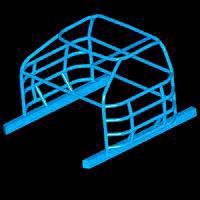Inkjet & Digital Printing
COMPETITIVE EDGE

Wednesday 26. March 2014 - FDM Improves Performance of Company's Seven Race Teams
When half a second separates an entire field of drivers, small performance gains make the difference between winning and losing. While the 27 engineers at Joe Gibbs Racing had lots of innovative design concepts to boost competitiveness, their ideas were not making it onto the cars fast enough for the next race.
Prototypes had to be machined on the company’s CNC mills, but the 15 mills were busy day and night machining production parts for JGR’s 70 cars. It was tough to get machine time for prototyping, and a five-week backlog left new designs stuck in the concept phase longer than desired.
At JGR, new design concepts must balance weight reduction, power increase, and control- and-handling improvement, all while adhering to NASCAR’s stringent standards. This yields extremely complex part designs. “When milling these prototypes, we could have as many as seven machine setups. This was an inefficient use of our machines and manpower,” says JGR technical director Mark Bringle. “A prototyping system can make these complex parts in one operation, and it doesn’t require CAM programming,” he says. “So we looked into our options.”
Real Solution
“We evaluated nine prototyping technologies but settled on the Fortus fused deposition modeling (FDM) process for two simple reasons. First, FDM didn’t require any facility modifications. We have a huge facility here, but there was no space for a special room that’s required by some prototyping processes. Second, we wanted to model with the strong thermoplastics available for FDM – Polycarbonate and Polyphenylsulfone. We can build prototypes tough enough to bolt onto the car, even the engine block, for evaluation, and they can take the heat.
“With our FDM machine, we can start building new concepts 15 minutes after the CAD design is complete,” says Bringle. “And prototypes are ready within a day. Previously, prototyping took a minimum of a week, and the delays became longer when the inevitable design changes occurred. Now, with the FDM machine, we make the changes and build another prototype immediately after a design flaw is corrected.”
After only a few months of prototyping, JGR cleared its backlog of new design concepts. Many of these innovations are now giving the company’s seven race teams a competitive edge. “The FDM process allows our engineering team to get great ideas onto the cars quickly,” says Bringle. “This has been a big factor in Tony Stewart’s success.” Stewart, who drives the #20 Home Depot car, won the year’s NASCAR NEXTEL Cup series.
“From concept to car, that’s the beauty of FDM,” says Bringle. “Engineering concepts are tested in a day or two and then manufactured for the race on the coming weekend. FDM has permanently changed the way we do business. The drivers, the crew chiefs and the chief designer are all amazed, even slack jawed, at what we can do with FDM and how it has changed our process.”
